Ecosystem Degredation
2.5 The Attack of the Emerald Ash Borer in The United States
Wyatt T. Susich
The Emerald ash borer beetle has wreaked havoc on all species of ash trees since its arrival in the United States. It has spread from Michigan and is responsible for the deaths of tens of millions of ash trees. It has also caused hundreds of millions of dollars worth in damages to municipalities and tree nurseries. What can be done to solve this problem?
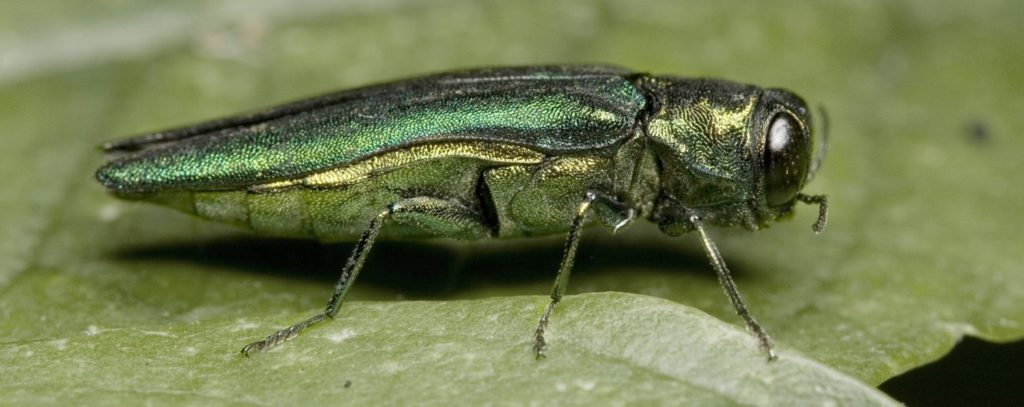
Photograph by David Cappaert, 2014. CC BY-NC-SA 3.0.
The Emerald ash borer beetle (EAB) (Figure 1) has created an incredible pest problem for many Midwestern and Northeastern states. The insect slowly deprives ash trees of nutrients, killing them over a period that may take several years. This issue has captured the attention of many governmental and environmental agencies, which are working together with researchers to understand and halt the destruction triggered by the spread of EAB. Current estimates suggest that EAB will cause $11 billion worth of damages from 2009-2019.1
The EAB beetle was discovered in Michigan in 2002. The beetle had not been previously seen in the United States, and it possibly arrived sometime in the 1990’s.2 Since then, the beetle has spread to states surrounding Michigan and into Quebec, Canada. It was likely transported to the United States on a cargo boat or plane carrying infected ash wood from Asia, its natural habitat. EAB has already killed tens of millions of North American ash trees.3
The Emerald ash borer is known to feed off all species of ash trees. Ash mortality occurs as a result of its larvae feeding on phloem within the trees during the beetle’s development. The larvae emerge from their eggs on the tree and burrow their way into the phloem layer, destroying the tree’s vascular system in the process (Figure 2). Once mature, the adult beetles will fly from their current tree to repeat the process on another ash tree. The timeline from initial infestation to death ranges from a single year in smaller trees, to 3-4 years in large trees. Within a forest stand, larger trees are more likely to be attacked and also attract more beetles than their smaller counterparts.4 EAB are also more likely to infest unhealthy ash trees, which will generally die faster than healthy trees once the larvae are inside the bark. The larvae feed downwards from the top of the tree towards the root structure. A 2011 study concluded that tree moisture content and nutrition drove this behavior.3 The life development, mating, and feeding patterns of EAB are well understood, but applying this information to find a solution to ending its North American invasion is an ongoing challenge.
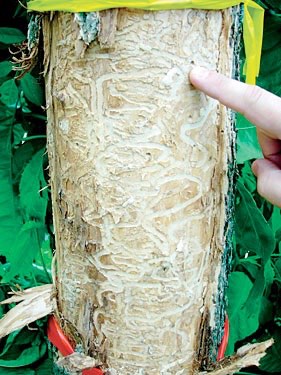
Photograph by the USDA Forest Service, 2004. Public Domain.
Despite all efforts to eradicate EAB, progress has been limited. It is estimated that eventually nearly all ash trees in North America will be decimated.5 One recent study conducted in Ohio concluded that for a given population of ash trees in a stand, nearly complete mortality is experienced for all trees in six years, in all circumstances. In addition, relatively lower densities of ash trees were found to be more susceptible to early deaths.6 North American ash trees do not have the natural defenses that their counterparts in Asia have to fend off the beetle. EAB is classified as an invasive species, and it currently lacks sufficient predators in North America to keep its population under control. There are now regulations in place to limit the spread of EAB, such as quarantining the transportation of firewood to prevent potentially infested wood from affecting new areas (Figure 5). A variety of different methods for killing EAB have been proposed, including traps, decoys, and introducing new predators (Figure 3).
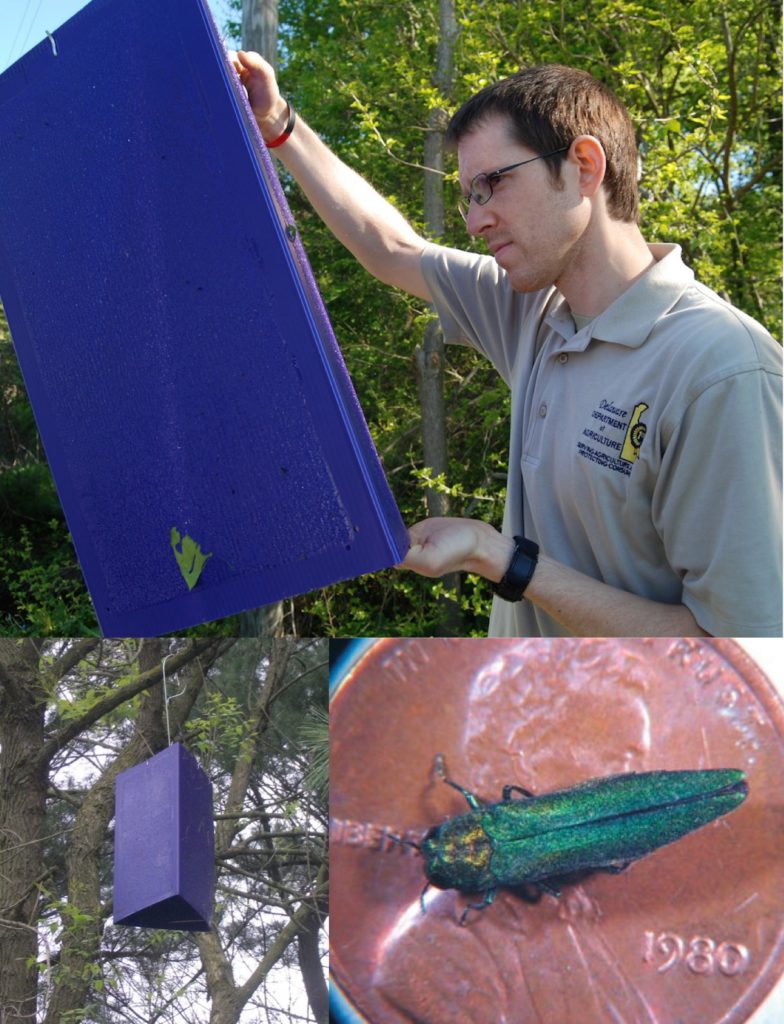
Courtesy of the Delaware Department of Agriculture, 2013. CC BY 2.0 (Top, Left) and the USDA Forest Service, 2004. Public Domain (Right).
Traps have seen limited success thus far due to difficulties in producing a reliable trap on an industrial scale. One study conducted in Hungary attempted to solve this production problem by producing a replica trap of a female EAB. EAB’s general mating pattern involves a male copulating with a female on an ash leaflet.2 The male spots the female on the leaflet by visually detecting the iridescent green color of the female’s elytra. With this knowledge, the scientists made traps that resembled the upper body of females by using positive and negative dies (created from a dead female) stamped onto a polymer sheet. The traps were somewhat successful in capturing EAB males but they also caught other species of beetles, signifying a need for further design modifications. This trapping strategy would be able to be replicated on an industrial scale because nearly 100 decoys were made from only one dead female. The female decoy trap may hold promise for the future of EAB control, especially considering females mate with multiple males to ensure maximal fecundity.2,7
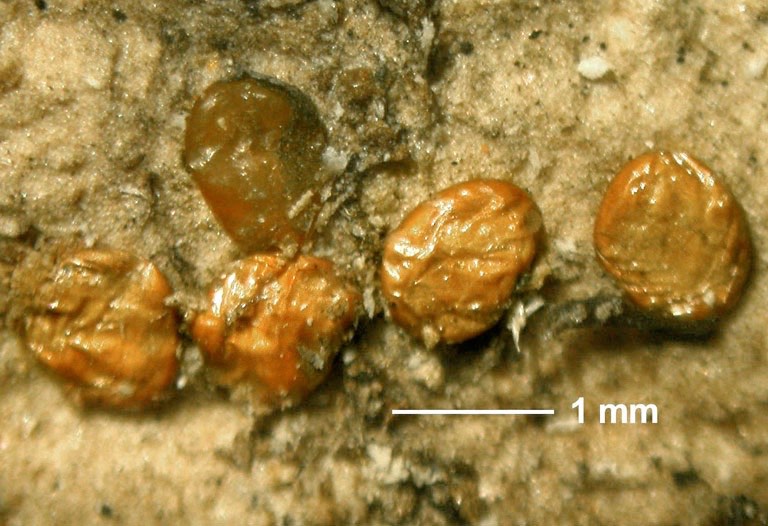
Photograph by David Cappeart, 2014. CC BY-NC-SA 3.0.
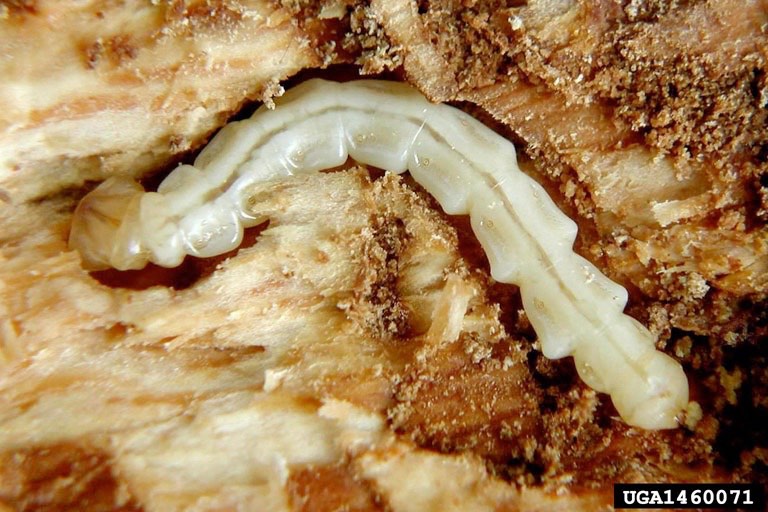
Photograph by David Cappaert, 2014. CC BY-NC-SA 3.0.
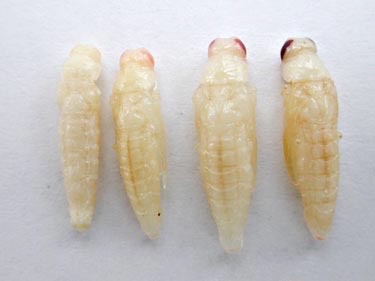
Courtesy of the USDA Forest Service, 2004. Public Domain.
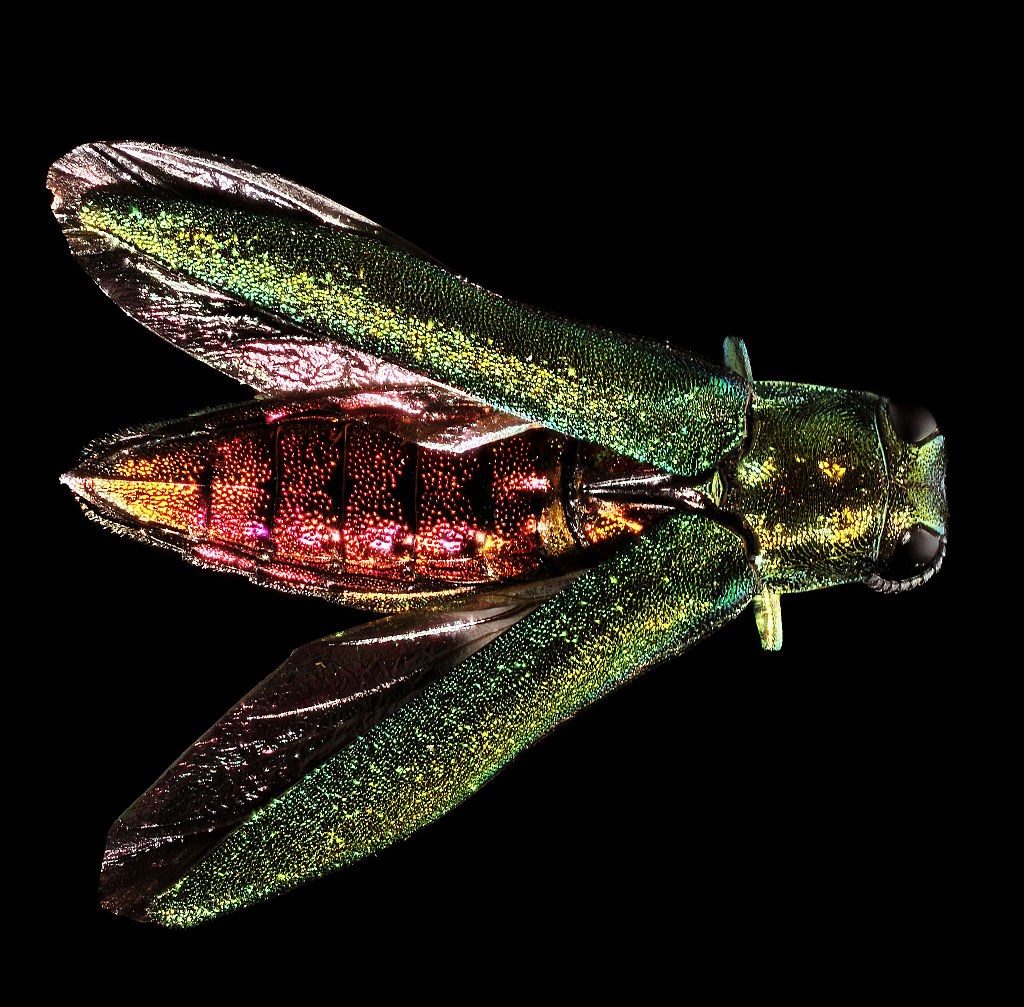
Photograph by Benjamin Smith, 2014. CC-BY 2.0.
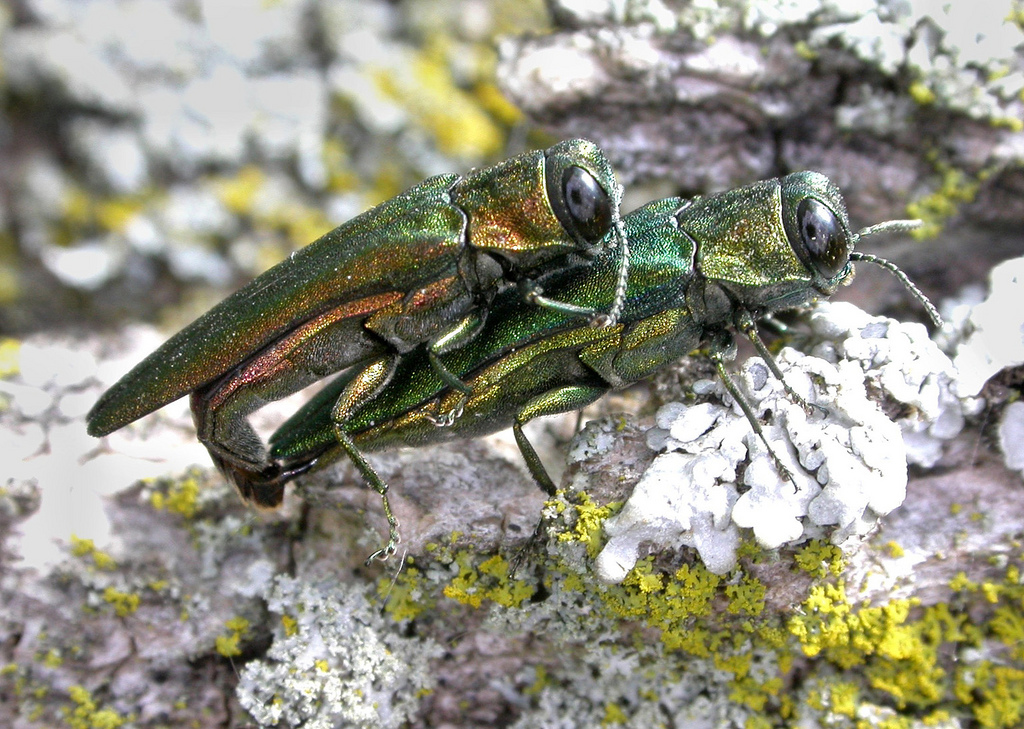
Photograph by David Cappaert, 2010. CC BY 2.0.
Placement and density of traps is as important as choosing the type of trap. Research results regarding this area have been mixed. One study suggested that an effective way to slow EAB population growth is to deploy a large number of trap trees in a heavily infested area which will attract beetles from surrounding areas. Once the beetles arrive, the trap trees are destroyed.8 Another study concluded that trap location and abundance of ash phloem near traps had no significant effect on EAB captures.9 More research on traps and decoys is needed to create an easily replicated and effective trap that is suitable for long term use.
The deployment of a predator species against EAB could be the most effective way to combat the invasion. The Emerald ash borer is not heavily preyed upon in North America. There are however, some natural predators in the United States such as wasps and bark-foraging birds that may be able to effectively prey upon EAB. One small-sample size study conducted in Ohio closely monitored woodpecker activity around a few ash trees for two years.10 The study discovered that the woodpeckers killed 85 percent of emerald ash borers in infested trees. In addition, woodpecker populations appeared to rise in response to an increase in EAB populations. The researchers suggested that while woodpeckers will not save a tree that has already been infested, they have the potential to save a forest and perhaps control the spread of EAB on a large scale.
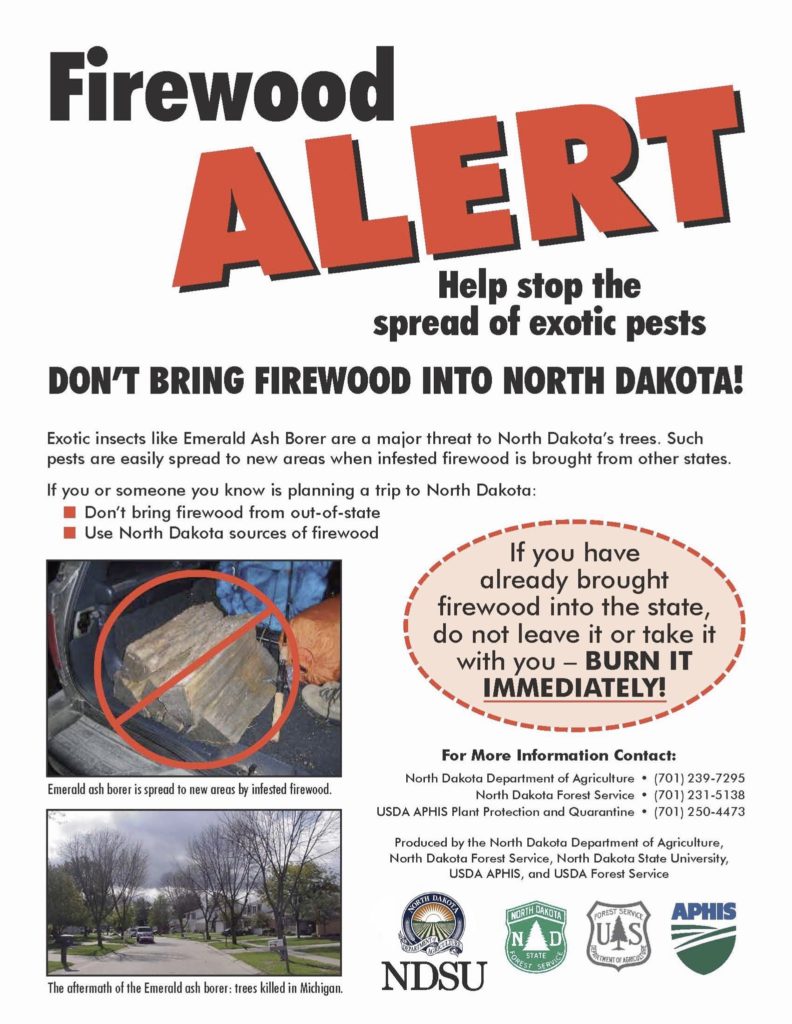
North Dakota Forest Service, 2011. CC BY-NC-SA 3.0.
While none of these methods have yet to demonstrate the ability to completely exterminate a population of Emerald ash borers in a given area, understanding that complete eradication of EAB is not necessary to save North America’s ash trees. As demonstrated in Asia, lower EAB densities may not cause ash mortality.5 Complete eradication of EAB in North America may never be feasible, but controlling its numbers is a manageable challenge. With increased research, there is hope that scientists will develop a protocol to protect the ash trees from extirpation in the near future. Meanwhile, people and businesses are faced with huge costs resulting from unprecedented ash tree loses. Companies involved in logging and tree industries (e.g. nurseries) cannot afford the financial burden imposed by EAB and the problem will likely worsen if a effective population control mechanism is not found.
References
- Kovacs, K.F., et al. (2010). Cost of potential emerald ash borer damage in US communities, 2009-2019, Ecological Economics, 69:569-578
- Pulsifer, D.P., et al. (2013). Fabrication of Polymeric Visual Decoys for the Male Emerald Ash Borer (Agrilus planipennis), Journal of Bionic Engineering, 10:129-138
- Chen, Y.G., et al. (2011). Moisture content and nutrition as selection forces for emerald ash borer larval feeding behaviour,Ecological Entomology, 36:344-354
- Marshall, J.M., et al. (2013) Estimates of Agrilus planipennis Infestation Rates and Potential Survival of Ash, American Midland Naturalist, 169:179-193
- DeSantis, R.D., et al. (2013). Effects of climate on emerald ash borer mortality and the potential for ash survival in North America, Agricultural and Forest Meteorology, 178:120-128
- Knight, K.S., et al. (2013). Factors affecting the survival of ash (Fraxinus spp.) trees infested by emerald ash borer (Agrilus planipennis), Biological Invasions, 15:371-383
- Rutledge, C.E., & Keena, M.A., (2012). Mating Frequency and Fecundity in the Emerald Ash Borer Agrilus planipennis (Coleoptera: Buprestidae), Annals of the Entomological Society of America, 105:66-72
- Fierke, M.K., et al. (2013). Delimitation and management of emerald ash borer (Coleoptera: Buprestidae): case study at an outlier infestation in southwestern New York State, United States of America, Canadian Entomologist 145:577-587.
- McCullough, D.G., et al. (2011). Effects of Trap Type, Placement and Ash Distribution on Emerald Ash Borer Captures in a Low Density Site, Environmental Entomology, 40:1239-1252
- Galatzer-Levy, J. (2013, December). Emerald ash borer may have met its match. University of Illionois at Chicago News Center. Retrieved from: http://news.uic.edu/emerald-ash-borer-may-have-met-its-match
- Cappaert, David. (2014). EAB Collection Gallery [Photographs]. Michigan State University. Retrieved from http://www.ag.ndsu.edu/ndae4hyw/invasives/emeral-ash-borer. CC BY-NC-SA 3.0.
- Forest Service, USDA. (2004). Green ash killed by Emerald Ash Borer. [Photograph]. Retrieved from Wikimedia Commons. Public Domain
- Delaware Department of Agriculture. (2013). Emerald Ash Borer traps 1. [Photographs]. Retrieved from FlickrCommons. CC BY 2.0.
- Delaware Department of Agriculture. (2013). Emerald Ash Borer traps 2. [Photographs]. Retrieved from FlickrCommons. CC BY 2.0.
- Forest Service, USDA. (2004). An adult Emerald Ash Borer on a penny. [Photograph]. Retrieved from Wikimedia Commons. Public Domain.
- Forest Service, USDA. (2004). Dorsal view of Emerald Ash Borer pupae. [Photograph]. Retrieved from Wikimedia Commons. Public Domain.
- Smith, Benjamin. (2014). Agrilus planipennis – Emerald Ash Borer. [Photograph]. Retrieved from Wikimedia Commons. CC BY 2.0.
- Cappaert, David. (2010). Emerald Ash Borer mating. [Photograph]. Michigan State University. Retrieved from FlickrCommons. CC BY 2.0.
- North Dakota Forest Service. (2011). 2011 Firewood Alert. [Flyer]. Retrieved from http://www.ag.ndsu.edu/ndae4hyw/invasives/emeral-ash-borer. CC BY-NC-SA 3.0.
